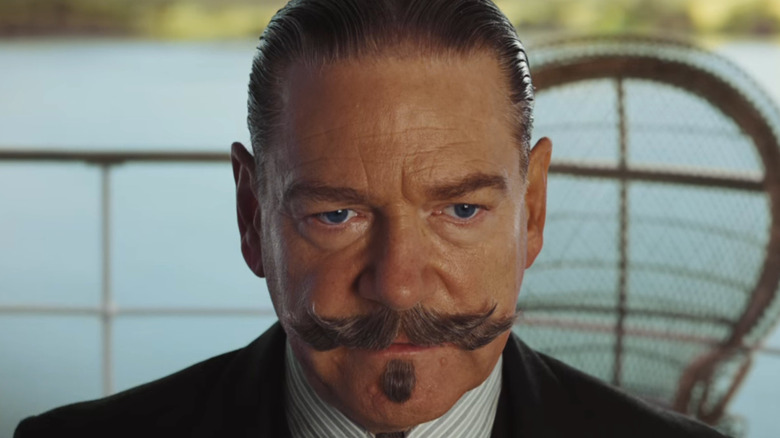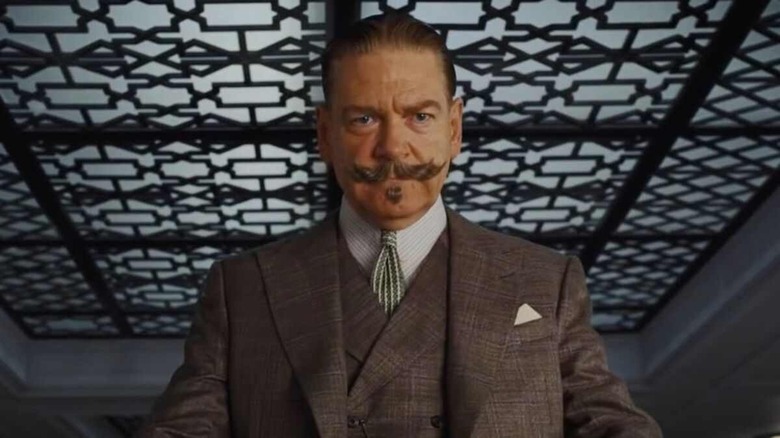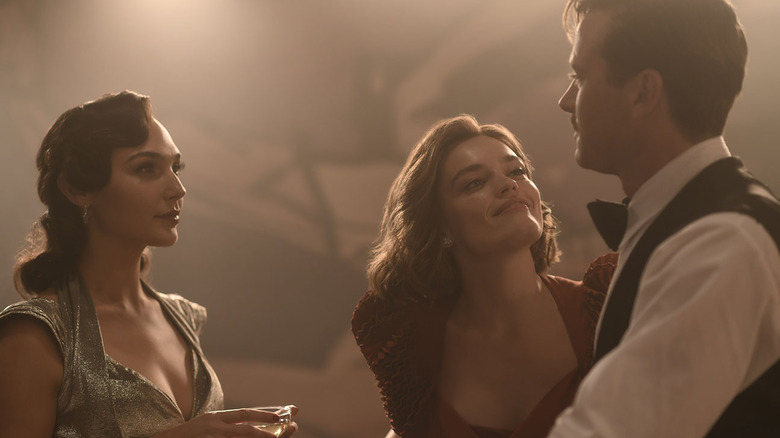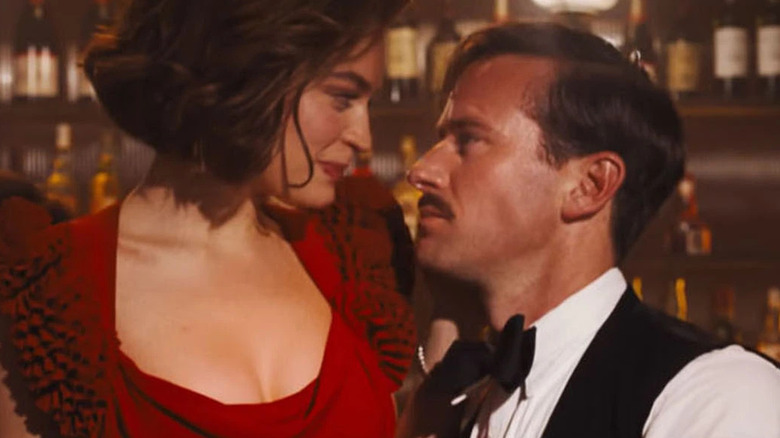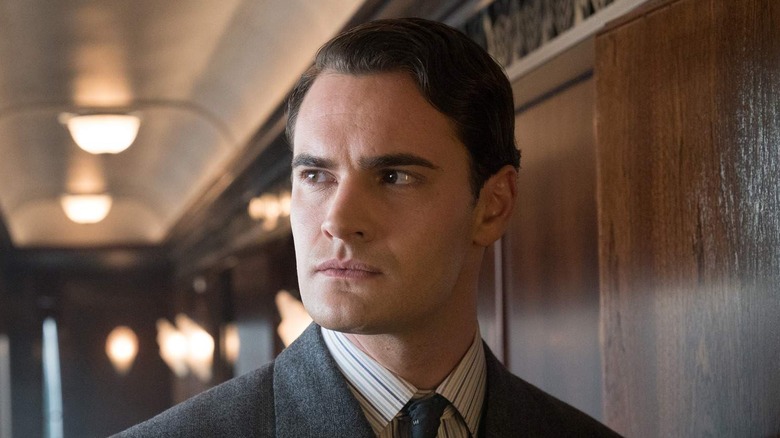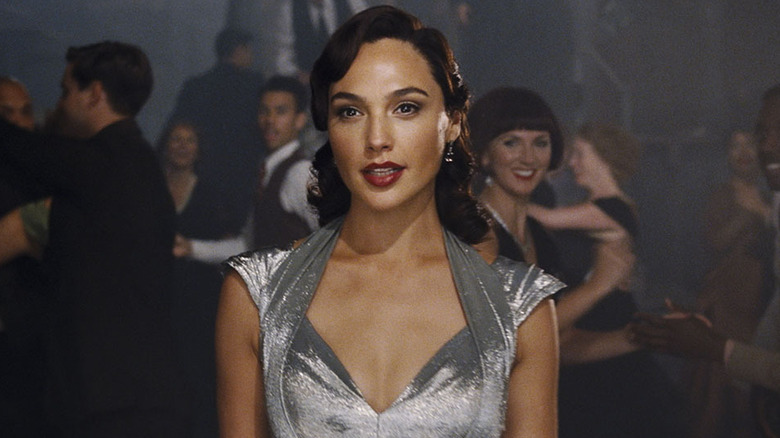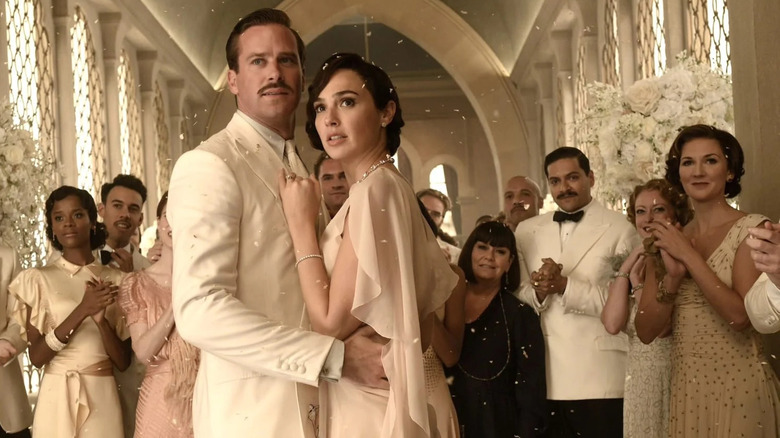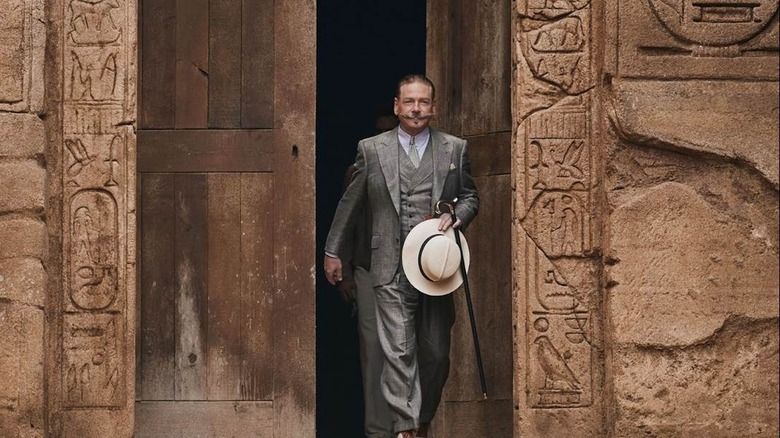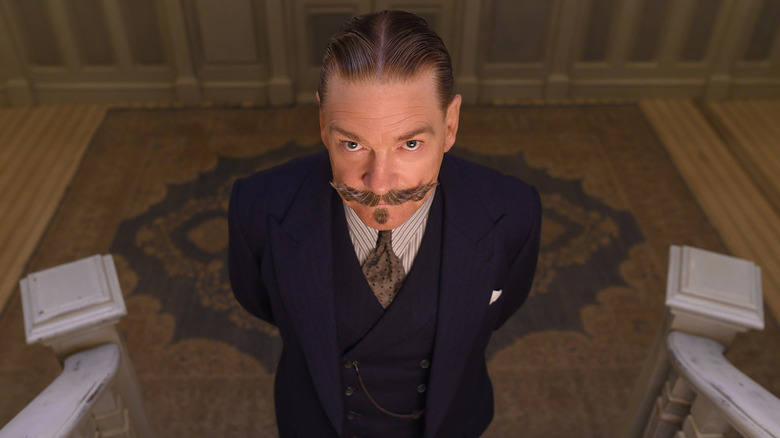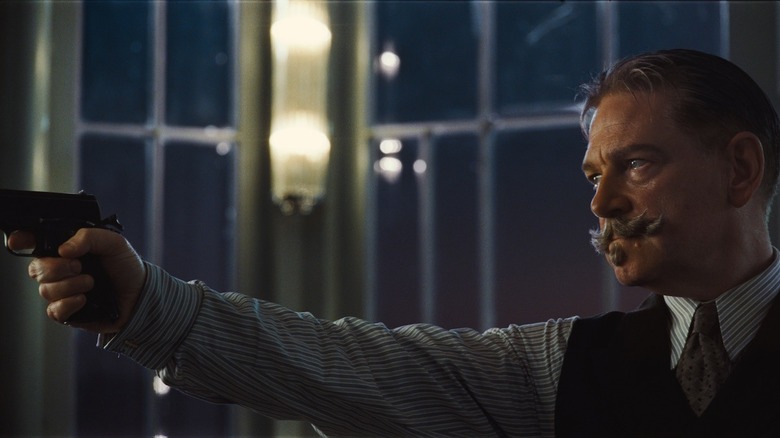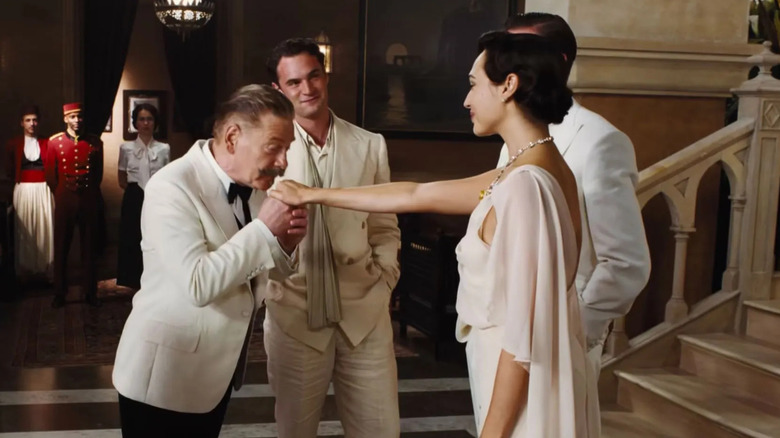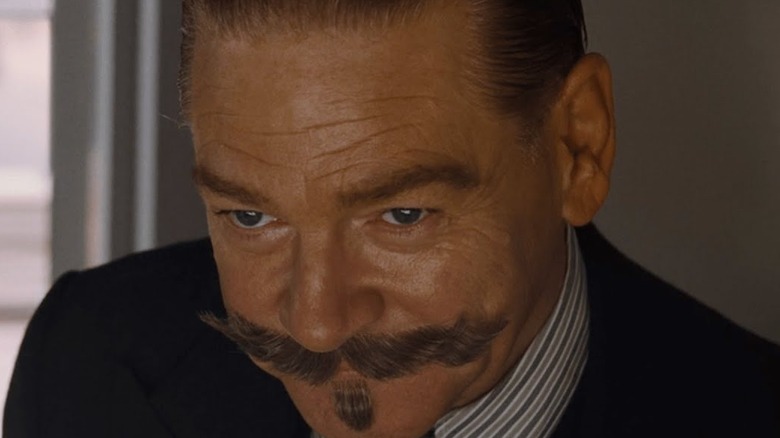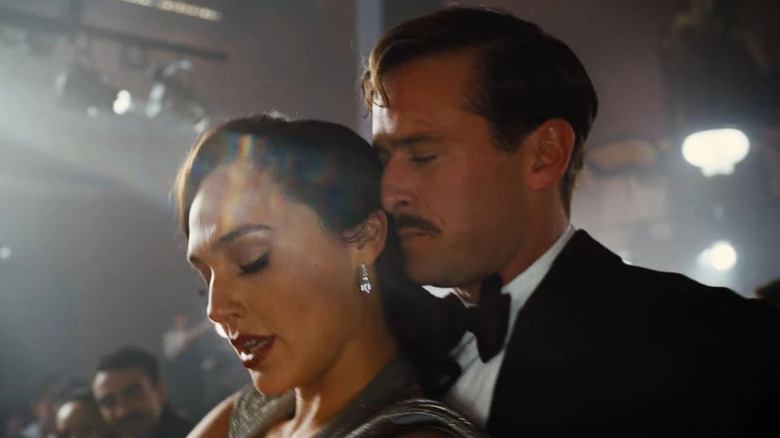The Ending Of Death On The Nile Explained
Director Kenneth Branagh returns with "Death on the Nile," his long-awaited sequel to 2017's surprise hit, "Murder on the Orient Express." Both films see the director-star as author Agatha Christie's most famous creation, Hercule Poirot, the world-famous detective with a knack for spotting the significant details in any mystery. Based on Christie's 1937 novel of the same name, "Death on the Nile" features Poirot investigating a murder during a wealthy socialite couple's honeymoon cruise down Egypt's Nile River.
Though it follows many of the core beats of the original story, the "Death on the Nile" film greatly expands upon the character of Hercule Poirot, exploring his motivations, ego, and flaws. It also develops his backstory in a way Agatha Christie never did, explaining the origins of his iconic mustache and giving him a romantic past that was never part of his literary incarnation.
"Death on the Nile" tells a complex story of love, murder, and failure. Let's start at the beginning and make our way through the film, examining every key plot point along the way. Spoilers ahead!
The prologue
The opening of "Death on the Nile" shows Poirot as a young man in World War I. The sequence, shot in gorgeous black and white, shows an officer barking orders to his troops. The officer has distinct facial hair, and the viewer is initially led to believe this is a younger Hercule Poirot played by a different actor. However, this is quickly revealed not to be the case, as Kenneth Branagh makes his first appearance as the character, a young soldier who offers insight into how they might ambush the enemy and avoid being killed in the trench warfare meat grinder of "no man's land."
For his appearance as a young Poirot, Branagh is digitally de-aged, and the effect is stunningly effective. His wrinkles are absent, and with his clean-shaven babyface, he looks just as he did in the 1990s. Poirot successfully leads his men to victory, ambushing the enemy and forcing a retreat. Before he can gloat about his keen instincts, though, Poirot's mustachioed commanding officer walks into an explosive tripwire trap, causing a massive detonation.
When Poirot awakens in a field hospital, he is visited by his lover, Katherine (Susannah Fielding), who tries to console him over the loss of his friend. Poirot turns to her, revealing that his face has been disfigured in the blast — a sight that might be disturbing to some viewers. Ever the optimist, Katherine simply tells him that he will cover his injury by growing a mustache.
The second prologue
The film picks up with a second prologue set in 1937, the year of the original novel's publication. Poirot is seated at a nightclub, watching a blues singer and guitarist (Sophie Okonedo) while observing a particularly raunchy dance between a romantic couple. The two, Simon and Jacqueline — played by Armie Hammer and Emma Mackey, respectively — are engaged to be married. A love triangle is formed when Linnet (Gal Gadot), a friend of Jacqueline's, borrows Simon for a dance, and the instant chemistry between the two causes Jacqueline no shortage of visible heartbreak.
This sequence is original to the film, as the novel conveys the backstory of the love triangle in exposition. Since there is already enough exposition in any given detective mystery, it makes sense for "Death on the Nile" to employ "show, don't tell" storytelling whenever possible, even if it means audiences are treated to two prologues before the movie truly begins in earnest. It also helps introduce several of the characters who will eventually become key players in the mystery later on, including the blues singer and her daughter (Letitia Wright).
The love triangle
The second prologue resolves a potential plot hole set up in "Murder on the Orient Express," which ends with Poirot dispatched to Egypt to investigate a murder on the Nile River, clearly intended as a sequel hook for "Death on the Nile." However, Poirot visits the nightclub to celebrate successfully solving that unseen case. It's a bit of a leap in storytelling logic since Poirot will inevitably be sent back to Egypt on a completely unrelated matter, but the film had to write itself out of the corner somehow.
The film picks up in Egypt six weeks later. After a chance (or is it?) meeting with his old friend, Bouc — the only other returning cast member from "Murder on the Orient Express" — Poirot finds himself once more in the company of Simon, Linnet, and Jacqueline. Only this time, Simon is celebrating his new marriage to Linnet — not Jacqueline, to whom he was engaged in the second prologue.
All's fair in love and war, but Jacqueline may be taking her scorn a bit too far. She has been stalking the happy couple across their entire honeymoon, offering menacing glances and reveling in the awkward discomfort. After an accident involving a falling stone nearly crushing Simon and Linnet (or was it just an accident?), the party decides to move to a chartered cruise down the Nile River, where the bulk of the film is set. Unfortunately, Jacqueline somehow learns of the plan and boards the ship.
Bouc and his mother
Bouc (Tom Bateman) and his mother (Annette Bening) are secretly responsible for the perceived coincidence that puts Poirot on the S.S. Karnak. Bouc is in love with Rosalie Otterbourne (Letitia Wright), and Bouc's mother, a painter and aristocrat, disapproves. To determine whether her instinct is correct, she hires Poirot to spy on Rosalie and determine whether or not she is deserving of marriage into Bouc's family. Bouc feels betrayed by Poirot, who insists that Rosalie is more than worthy of marriage, but Bouc's mother still steadfastly refuses to give her blessing to their courtship. It's an unexpected source of drama that makes Bouc's return in "Death on the Nile" more than just a gimmick. (It's worth noting that Bouc did not appear in the original novel.)
Another wrinkle in this storyline comes in the form of Poirot's unexpected attraction to Rosalie's mother, blues guitarist and singer Salome Otterbourne (Sophie Okonedo). Their interactions cause Poirot to divulge his own romantic past and how Katherine died in an accident while on the way to visit him in the hospital over Christmas. After that tragedy, Poirot never succumbed to love again. As he says, "I have my cases." Still, in both "Murder on the Orient Express" and "Death on the Nile," Poirot is seen gazing longingly at a photograph of Katherine, indicating he still holds a torch for his long-lost love.
The murder — who dies?
One night on the S.S. Karnak, Poirot retires early due to a combination of seasickness and a glass of champagne (it seems he can't handle his booze). Linnet also goes to bed early, leaving Jacqueline and Simon to bicker as exes tend to bicker. However, Jacqueline appears to have something of a mental break, drawing a pistol and firing a shot. Simon grabs his leg, and Jacqueline is dragged away, her gun falling from her hand and mysteriously disappearing in the scuffle. Jacqueline is brought to the bedroom of Marie and her assistant/secret lover, Bowers, to be watched over during the night. Meanwhile, Dr. Windlesham (Russell Brand), Linnet's former flame, attends to Simon's leg wound.
In the morning, Linnet's servant, Louise, goes to wake her and finds her friend dead with a bullet in her head. Additionally, her outrageously expensive jeweled necklace is missing. The obvious suspect is Jacqueline, but she was under observation all night. When Poirot finally wakes up and emerges from his quarters with something of a mild hangover, he realizes he has a new mission: finding justice for Linnet and figuring out who on the S.S. Karnak is responsible for the worst honeymoon ever.
The suspects
Everyone is a suspect, but one by one, Poirot interrogates and clears them of the crime. Along the way, he determines that Marie and Bowers are a secret couple, but he's not the type to judge a queer relationship between consenting adults. He becomes suspicious of Linnet's cousin and lawyer, Andrew (Ali Fazal), who lost lots of Linnet's money via poor market speculation. Poirot ultimately deduces that Andrew is the one who nearly killed Simon and Linnet with the boulder before they boarded the Karnak but is innocent of the crime at hand.
Shockingly, Poirot's suspicions turn to his own friend, Bouc. Despite enjoying luxury, Bouc is not a rich man. No, he's more of a leisurely playboy who coasts through life on charm and hanging on to others' coattails than through any merit of his own. Could Bouc, Poirot's most trusted friend — his only friend, for that matter — have killed Linnet while attempting to steal her precious jeweled necklace? After all, Bouc, stricken by the most fatal disease of all — love — would do anything to make himself worthy of Rosalie's affections.
The body count rises
Eventually, a second body is discovered: Linnet's assistant, Louise (Rose Leslie), one of the primary suspects. Did she witness Bouc's crime and pay the price for what she saw? Things aren't looking good for Bouc, and Poirot is increasingly suspicious of what appears to be his former friend. Meanwhile, the crew members searching for evidence manage to find the missing handgun on the bottom of the river, wrapped in a scarf. However, they could not find a jar of red paint belonging to Bouc's mother, which disappeared before the murder.
A potential break in the case is made when the missing jewelry conspicuously reappears in Bouc's mother's room. She's not a suspect, so it seems whoever planted it there did so knowing that it was a safe spot to avoid drawing suspicion to someone who didn't deserve it. Poirot concludes that the theft of the jewelry is a separate crime from the murder of Linnet and believes the apologetic thief attempted to undo his crime by returning the jewels.
It becomes personal
Poirot interrogates Bouc with Simon present. Bouc admits to stealing the jewels in a moment of weakness but says he returned them for the sake of his mortal soul and his status as a good person. He also admits he witnessed Louise's murder. However, before he can reveal the killer's identity, a shot rings out, striking Bouc in the neck. He bleeds out and dies within seconds, and Poirot can do nothing to help his friend, whom he had scorned for no reason. Poirot is devastated by this turn of events.
In the original story, which doesn't feature Bouc at all, it's Ms. Otterbourne who is shot and killed during the interrogation. Additionally, she is an author, not a musician. This change greatly influences how the rest of the film plays out. By this point, Poirot has failed three innocent people, just as he failed his commanding officer all those years ago in the war. They're all dead because he didn't solve the case fast enough, just as he didn't notice the wartime trap until it was too late.
Poirot unhinged
Driven to action by the death of his friend, Poirot doubles down on his investigation and figures out the truth. After recovering the weapon used to murder Bouc (it belonged to Andrew, but that's not of significant importance), Poirot uses it to effectively hold the entire cast hostage, locking them all in the lounge area before delivering his summation of the case and exposing the guilty parties. He's called out on his egotism, narcissism, and smug demeanor, but he's only got one thing on his mind: righteous justice.
Poirot systematically goes through the entire crime, pulling it apart from every angle and examining every piece of evidence, including the gun and scarf pulled from the water. Poirot blows the case wide open by examining the scarf used by Simon to soak up the blood on his leg when he was shot. When blood dries and fades, it becomes brown. The so-called blood on Simon's scarf is pink, indicating it is not blood at all, but red paint, stolen from Bouc's mother to aid in the deception. Jacqueline never shot Simon.
Who did it?
While Jacqueline was being taken away, Simon grabbed the discarded handgun and raced down to his sleeping wife. After shooting her to death, he returned to where he had supposedly been shot and shot himself in the leg, using a scarf to silence the bullet. He then wrapped the pistol with the scarf and threw it overboard. Simon and Jacqueline drugged Poirot's champagne in an attempt to knock him off the playing board so they could commit their crime without such a dangerous variable on the table. Jacqueline subsequently murdered Louise for being a potential witness and suspicious loose end and murdered Bouc for being a witness to the murder of Louise.
The whole time, Simon's courtship of Linnet was just a ruse to get her money. Simon had never scorned Jacqueline and was always in love with her — they schemed together to kill Linnet and steal her fortune. Louise and Bouc were just in the way, in the wrong places at the wrong times. That being said, Jacqueline perhaps wasn't playing up her psychotic sensibilities. With no way out, she embraces Simon in one last hug and then draws a hidden handgun, places the barrel against Simon's back, and pulls the trigger. A single bullet pierces both of their bodies, and they both die in each other's arms.
Does Poirot find love?
Poirot has solved the case, but too late to save the lives of three innocent victims (Linnet was no treat, but she wasn't a criminal) and two murderers. Five people in total died on his watch. Was it because he opened himself up to the possibility of a romance with Salome Otterbourne? He cannot say for sure, but it's enough for him to curse himself. He doubted his friend, Bouc, and was forced to watch him die.
In the original Agatha Christie stories, Poirot never has a romantic interest. He is chaste and only has a passion for solving crimes. The character of Katherine — as well as the romantic chemistry between Poirot and Ms. Otterbourne — is a creation of the filmmakers. Poirot's self-doubt and feeling of failure following the closure of the "Death on the Nile" murder case may indicate why Poirot sees himself as a man dedicated to a purpose higher than love: justice, and helping people using his unique detective skills.
The epilogue
The final scene of "Death on the Nile" sees Ms. Otterbourne rehearsing at the same nightclub from the beginning of the film. As she sings the blues, Poirot slowly enters the venue and sits down. When the camera finally catches a glimpse of his face, it's revealed that Poirot has shaved his signature facial hair. His trademark gigantic mustache is gone, and the viewer can finally see the scars that have long been covered up by Poirot's vanity.
There is no dialogue in this brief scene, and as it slowly fades out, the viewer is left wondering the significance behind Poirot's new fashion choice. Throughout all of Agatha Christie's stories and all onscreen incarnations of Hercule Poirot, the detective is never seen without his trademark facial hair (though the World War I battle scars are an invention of this film). Without his mustache, who is Hercule Poirot?
What's next for Poirot?
Poirot's mustache is a symbol of his duty. He wears it as a reminder of his old commanding officer, who wore the same mustache and died because Poirot was too slow in pointing out the trap that ultimately kills his ally and maims his own face. He feels responsible for his death, just as he feels responsible for the death of Bouc. It's a reminder of Katherine, who instructed him to grow the mustache in the first place. And it's a symbol of his vanity and ego — traits that are only aggrandized every time he successfully solves a case and delivers a murderer to justice.
The ending of "Death on the Nile" implies that all of that is gone. It's implied that Poirot will quit being a detective and perhaps seek companionship from Ms. Otterbourne. But for Poirot, this is not a clean-cut happy ending. At the end of "Death on the Nile," he sees himself as unworthy of the praise he has accrued over the years. Hopefully, Kenneth Branagh will be able to make a third Poirot film, where the character can discover that all men make mistakes, and it's possible to recover from failure. Maybe Poirot will be able to achieve a balance in his life, maintaining his position as the world's greatest detective while also carving himself a slice of happiness with someone as warm and kind as Ms. Otterbourne.
